
The Cyperaceae are a family of graminoid (grass-like), monocotyledonous flowering plants known as sedges. The family is large, with some 5,500 known species described in about 90 genera, the largest being the "true sedges" genus Carex with over 2,000 species.

Stipa is a genus of around 300 large perennial hermaphroditic grasses collectively known as feather grass, needle grass, and spear grass. They are placed in the subfamily Pooideae and the tribe Stipeae, which also contains many species formerly assigned to Stipa, which have since been reclassified into new genera.
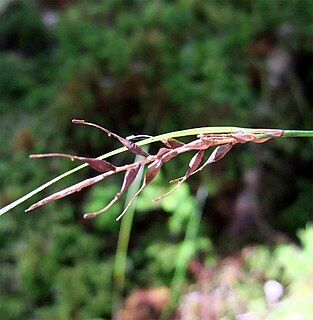
Uncinia is a genus of flowering plants in the family Cyperaceae, known as hook-sedges in Australia and as hook grasses or bastard grasses in New Zealand. The genus is characterised by the presence of a long hook formed by an extension of the rachilla, which is used to attach the fruit to passing animals (epizoochory), especially birds, and it is this feature which gives the genus its name, from the Latin uncinus, meaning a hook or barb.
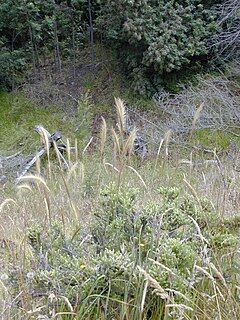
Dichelachne is a genus of Australian, Indonesian, and Pacific Island plants in the grass family. They are known commonly as plumegrasses.

Carex capillacea, common name yellowleaf sedge in Tasmania, is a species of sedge found in Assam, the far east of Russia, New Guinea, south east Australia, New Zealand, Malesia, China, Japan and India.

Carex fascicularis, commonly known as tassel sedge, is a species of sedge of the family Cyperaceae that is native to Australia, New Zealand and New Guinea.
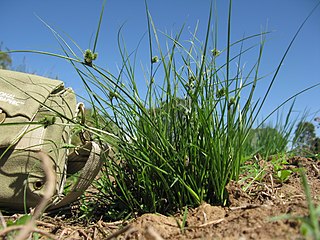
Carex inversa, commonly known as knob sedge, is a species of sedge of the family Cyperaceae that is native to parts of Australia and New Zealand and has also been introduced into Great Britain.
Carex tereticaulis, also known as basket sedge, is a species of sedge of the family Cyperaceae that is native to southern parts of Western Australia, southern parts of South Australia, southern and eastern parts of New South Wales as well as north western and central Victoria and Tasmania. The Koori peoples know the plant as Poong'ort.
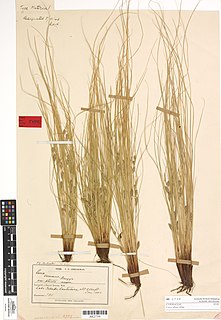
Carex albula, common name white sedge, is a species of sedge. It is endemic to the South Island of New Zealand.

Carex berggrenii, common name Berggren's Sedge, is a species of sedge. It is endemic to New Zealand, being found on both the North and the South Islands.

Carex buchananii, common names Buchanan's sedge, cutty grass, is a species of sedge. It is endemic to New Zealand, being found on both the North and South Islands.
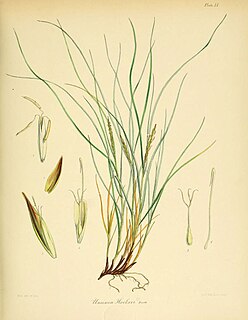
Carex erebus is a member of the sedge family and is found on the Antarctic Islands of Australia and New Zealand.

Carex amphibola, known as gray sedge, is a species of flowering plant in the family Cyperaceae. It was first formally named in 1855. Carex amphibola is native to the eastern United States and Canada.
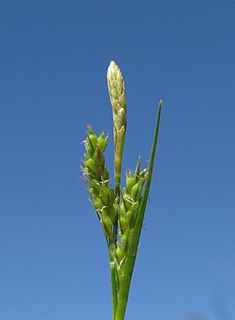
Carex breviculmis, called the Asian shortstem sedge, is a species of flowering plant in the genus Carex, native to Asia from the Indian subcontinent to Southeast Asia, China, Taiwan, Korea, Japan, north as far as Khabarovsk Krai, and Malesia, New Guinea, Australia, Norfolk Island and New Zealand. It has been introduced to the US state of Mississippi. Typically found in forests, it is quite shade tolerant.

Carex breviscapa is a tussock-forming perennial in the family Cyperaceae. It is native to eastern parts of the south east Asia and north eastern Australia

Carex ventosa, also known as Chatham Islands forest sedge, is a tussock-forming species of perennial sedge in the family Cyperaceae. It is native to the Chatham Islands.
Carex aureolensis is a tussock-forming species of perennial sedge in the family Cyperaceae. It is native to temperate parts of the Americas from Illinois in the north to northern Argentina in the south.
Carex fecunda is a tussock-forming species of perennial sedge in the family Cyperaceae. It is native to parts of South America.
Carex humboldtiana is a tussock-forming species of perennial sedge in the family Cyperaceae. It is native to parts of Central America and South America.
Carex hyalinolepis is a tussock-forming species of perennial sedge in the family Cyperaceae. It is native to southern parts of North America from Ontario in the north to Texas in the south.















